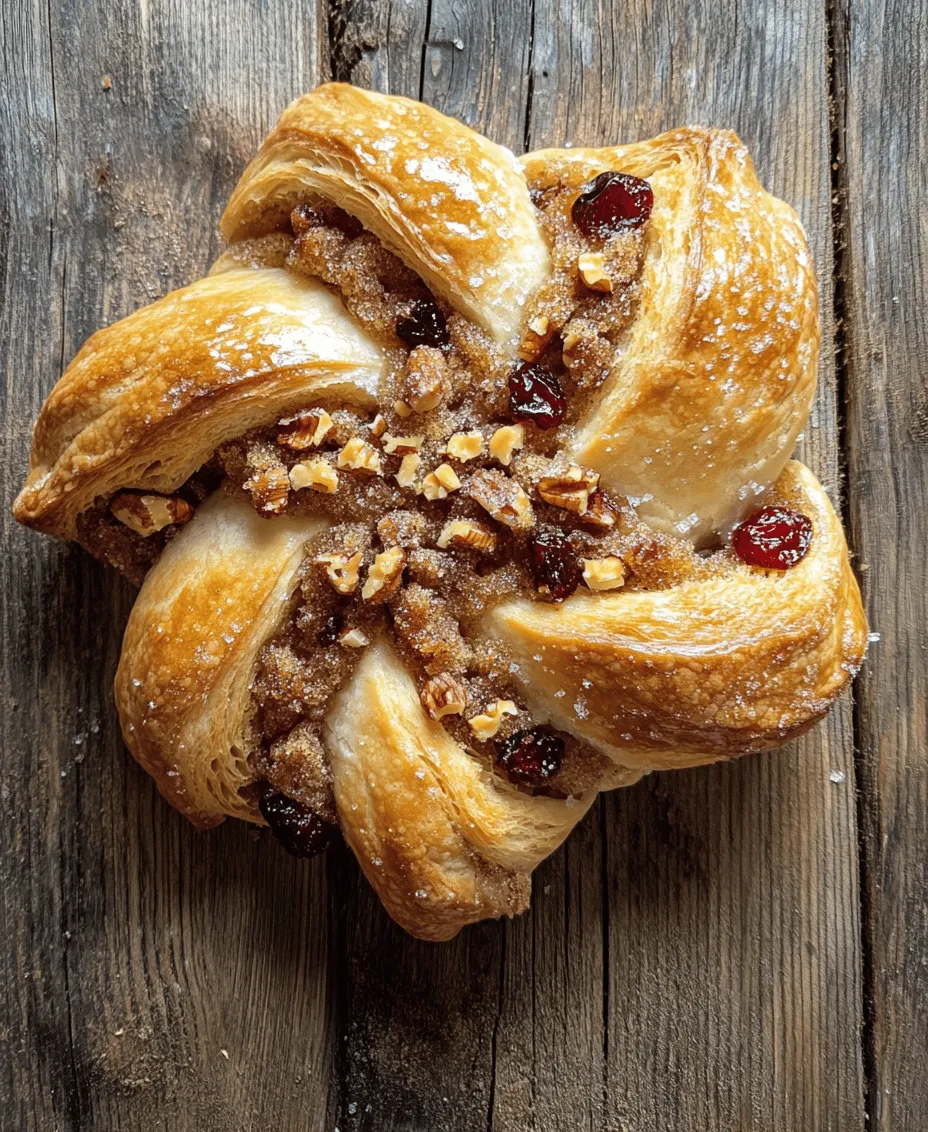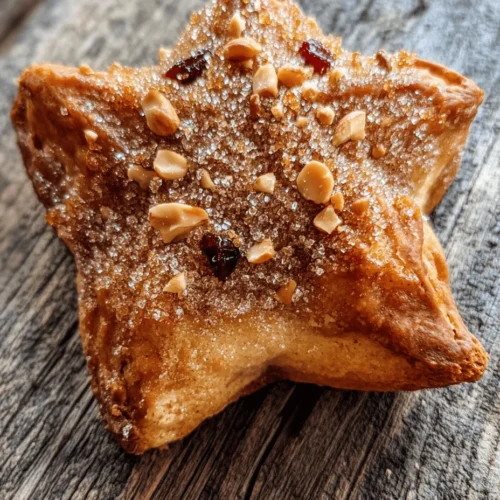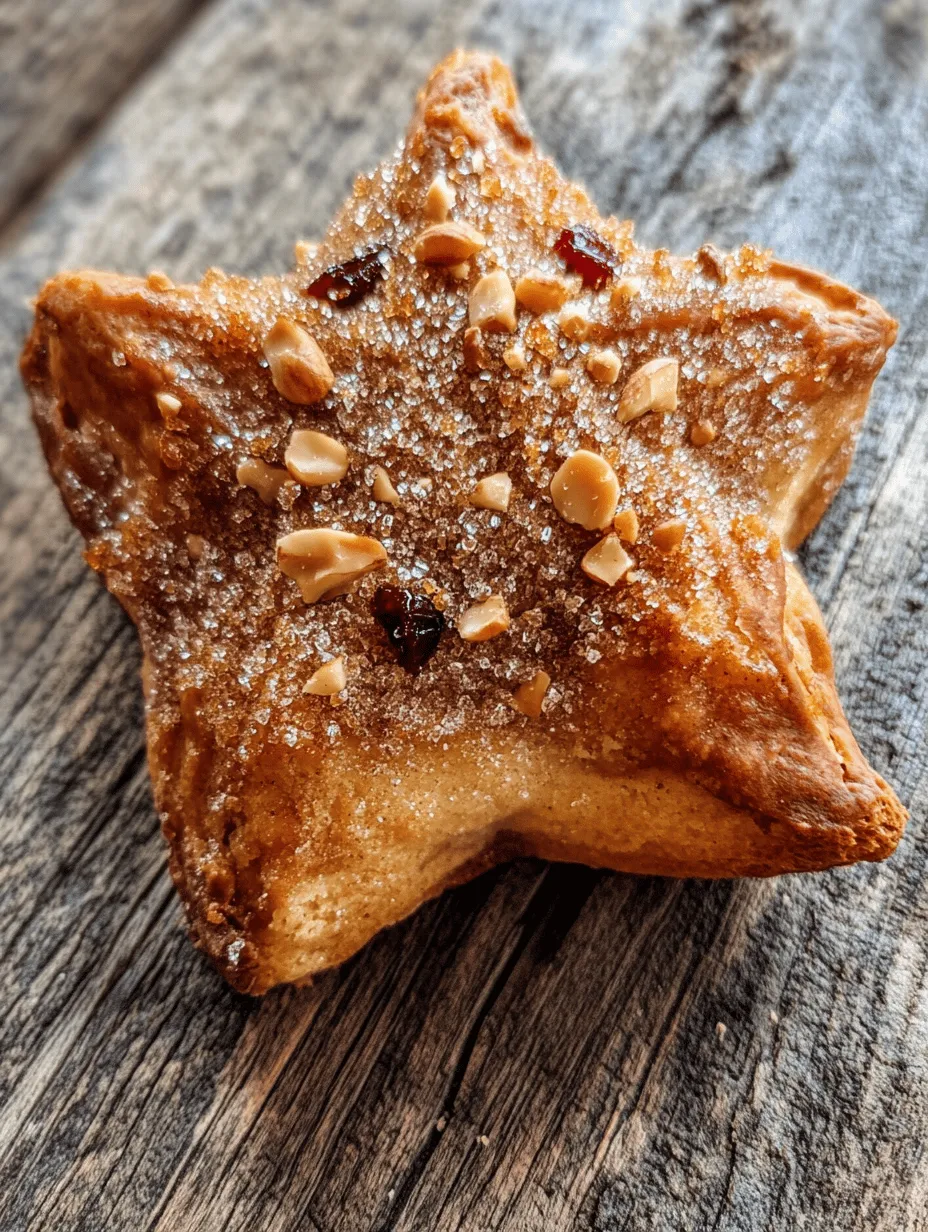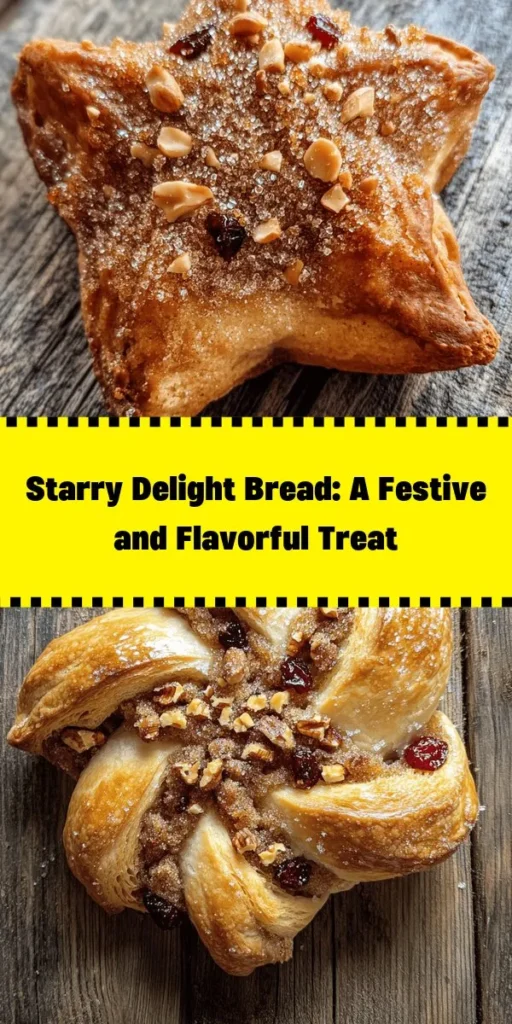Introduction
In the world of baking, few creations captivate the eye and palate like the Starry Delight Bread. This unique, visually stunning bread embodies both flavor and artistry, making it a delightful centerpiece for any gathering. With its star-shaped design, this bread not only satisfies the hunger for deliciousness but also brings a touch of creativity and joy to the baking experience. Whether you’re celebrating a special occasion or simply looking to impress family and friends, the Starry Delight Bread offers a perfect blend of taste and beauty.
The tradition of shaping bread into various forms has deep cultural roots, found in cuisines around the globe. From the intricate braided loaves of Eastern European heritage to the festive panettone of Italy, shaped breads have always held a special significance. They are often seen as symbols of celebration, togetherness, and creativity. The Starry Delight Bread continues this legacy, allowing home bakers to engage in the time-honored practice of baking while expressing their artistic side.
Baking at home brings a unique joy, filling the kitchen with delightful aromas and creating an opportunity for bonding over shared experiences. The process of making Starry Delight Bread invites you to explore your culinary creativity and share the rewards with loved ones. As you embark on this baking adventure, you’ll discover not only the satisfaction of creating something beautiful but also the happiness it brings to those who gather around your table.
The Allure of Starry Delight Bread
The appeal of Starry Delight Bread lies not only in its taste but also in its stunning aesthetics. The star-shaped design instantly catches the eye, making it an excellent choice for celebrations and gatherings. Picture this: a beautifully baked loaf, golden brown and perfectly shaped, placed at the center of your dining table. It serves as a conversation starter and a visual treat that elevates the dining experience for all ages.
One of the most exciting aspects of this recipe is its versatility. While the traditional version may feature a sweet filling of cinnamon and sugar, the Starry Delight Bread can easily be adapted to suit various tastes and preferences. For those who enjoy savory flavors, consider filling the dough with a mixture of herbs, cheese, or even roasted vegetables. The possibilities are endless, allowing you to customize the bread to match the theme of your gathering or the palate of your guests.
Moreover, the Starry Delight Bread enhances any table setting, making it perfect for holidays, family gatherings, or festive occasions. Its striking appearance draws attention, while its delicious taste leaves a lasting impression. Whether it’s a cozy family dinner or a grand holiday feast, this bread can complement your meal and provide a memorable experience for everyone involved.
Ingredients Breakdown
Creating the Starry Delight Bread requires a thoughtful selection of ingredients, each playing a vital role in the final product. Here’s a comprehensive list of what you’ll need, along with detailed descriptions of each ingredient’s purpose:
All-Purpose Flour
The backbone of the Starry Delight Bread, all-purpose flour is essential for creating the structure and texture of the dough. Its balanced protein content allows for a light, fluffy bread that still holds its shape. When measuring flour, it’s important to do so accurately, as too much or too little can affect the dough’s consistency and rise.
Active Dry Yeast
Active dry yeast is the key ingredient responsible for leavening the bread, giving it that delightful rise. It works by converting sugars into carbon dioxide, which causes the dough to expand and become airy. To activate the yeast properly, it’s crucial to use warm water or milk (about 110°F to 115°F), as temperatures that are too hot can kill the yeast, while too cold will prevent it from activating.
Warm Milk
Warm milk not only helps to activate the yeast but also enriches the dough, contributing to its overall richness and flavor. The milk adds moisture, creating a softer texture in the finished bread. When using warm milk, be sure to test the temperature with your finger; it should feel warm but not hot.
Sugar and Brown Sugar
Both sugar and brown sugar play a dual role in this recipe. They not only sweeten the bread but also help with browning during baking, creating a beautiful golden crust. Brown sugar, with its molasses content, adds depth of flavor and moisture. If you wish to adjust the sweetness, you can experiment with different amounts according to your taste preferences.
Unsalted Butter
Using unsalted butter gives you more control over the saltiness of your bread. It adds richness and flavor to the dough, making it taste indulgent without overwhelming the other flavors. Ensure that the butter is softened to room temperature before incorporating it into the dough for easier mixing.
Eggs
Eggs are crucial for adding moisture and richness to the dough. They also contribute to the bread’s structure and help with the leavening process. For best results, use large eggs, and consider bringing them to room temperature before mixing to ensure even blending into the dough.
Vanilla Extract, Salt, and Ground Cinnamon
These ingredients enhance the flavor profile of the Starry Delight Bread. Vanilla extract adds a warm, sweet aroma, while ground cinnamon provides a comforting spice that pairs beautifully with the sweetness of the bread. Salt is essential in balancing flavors, enhancing the overall taste of the loaf.
Optional Fillings (Nuts and Dried Fruits)
For those looking to add a personal twist, consider including optional fillings such as nuts, dried fruits, or chocolate chips. These additions can elevate the flavor and texture of your Starry Delight Bread, offering a delightful surprise with each bite. Suggestions for variations include walnuts, pecans, raisins, or cranberries, which can add both flavor and visual appeal.
Step-by-Step Instructions
Activating the Yeast
The first step in creating your Starry Delight Bread is to activate the yeast. This step is crucial for ensuring your bread rises properly. Begin by measuring out the warm milk into a mixing bowl. Add a teaspoon of sugar to the milk, which will provide the yeast with food as it activates.
Sprinkle the active dry yeast over the warm milk and let it sit for about 5 to 10 minutes. During this time, you should see the yeast start to foam and bubble, indicating that it is alive and ready to work its magic. If you don’t see any bubbling, it may be a sign that your yeast is inactive, and it’s best to start over with fresh yeast.
Making the Dough
Once your yeast is activated, it’s time to bring together the ingredients to form the dough. In a large mixing bowl, combine the all-purpose flour, salt, ground cinnamon, and the remainder of the sugar. Mix these dry ingredients together until they are evenly incorporated.
Next, create a well in the center of the flour mixture and add the activated yeast mixture, softened unsalted butter, and eggs. Using a wooden spoon or a dough whisk, begin mixing the wet and dry ingredients together. Continue to stir until a shaggy dough begins to form.
At this point, you should assess the consistency of your dough. If it feels too sticky, gradually add more flour, a tablespoon at a time, until it reaches a workable consistency. The dough should be soft but not overly sticky, allowing you to knead it easily.
Kneading Techniques
Kneading is a vital step in developing the gluten in the dough, which gives the bread its structure and chewiness. Once your dough is mixed, turn it out onto a floured surface. Begin kneading by pressing down on the dough with the heels of your hands, then folding it over and repeating the process.
Knead the dough for about 8 to 10 minutes, or until it becomes smooth and elastic. You can test the dough’s readiness by performing the “windowpane test.” Take a small piece of dough and stretch it gently. If it stretches thin enough to let light through without tearing, it’s ready for the next step.
Once kneaded, shape the dough into a ball and place it in a lightly greased bowl. Cover it with a clean kitchen towel or plastic wrap and let it rise in a warm, draft-free area until it doubles in size, typically about 1 to 2 hours. This step is essential for achieving the fluffy texture of your Starry Delight Bread.
With these foundational steps laid out, you are well on your way to creating a beautiful and delicious loaf of Starry Delight Bread that will impress everyone at your table.

Importance of Kneading for Gluten Development and Texture
Kneading is a crucial step in bread-making that significantly contributes to the texture and structure of the final product. When you knead the dough, you are developing gluten, a protein that gives bread its elasticity and strength. Gluten forms a network that traps air bubbles during fermentation, which allows the bread to rise and develop its characteristic chewy texture. For Starry Delight Bread, kneading should be thorough but gentle, allowing the dough to become smooth and pliable. Aim for about 10 minutes of kneading by hand or 5-7 minutes in a stand mixer on medium speed until the dough springs back when poked. This process not only enhances the texture but also ensures even distribution of ingredients, which is essential for a harmonious flavor throughout the bread.
Preparing the Filling
The filling is where you can truly personalize your Starry Delight Bread. The classic filling often consists of a mixture of cinnamon, sugar, and butter, but the possibilities are endless. For a delightful twist, consider adding ingredients like finely chopped nuts, dried fruits, or even chocolate chips. Here’s a basic filling recipe to get you started:
Ingredients for the Filling:
– 1/2 cup unsalted butter, softened
– 1 cup brown sugar
– 2 tablespoons ground cinnamon
– Optional: 1/2 cup chopped walnuts or pecans, 1/2 cup dried cranberries or raisins, or 1/2 cup chocolate chips.
Instructions for Filling Preparation:
1. In a bowl, mix the softened butter with brown sugar and cinnamon until well combined and creamy.
2. If desired, fold in any additional ingredients like nuts or dried fruits to create a unique flavor profile.
Feel free to experiment with different flavor combinations. For instance, a savory filling with garlic, herbs, and cheese can transform your Starry Delight Bread into an exquisite accompaniment for soups or salads.
Tips for Customizing the Filling
1. Flavor Variations: Swap out cinnamon for cardamom or nutmeg for a different flavor base.
2. Sweeteners: Use honey or maple syrup in place of sugar for a natural sweetener.
3. Add-Ins: Incorporate citrus zest, such as orange or lemon, for a refreshing twist.
4. Savory Options: Try incorporating ingredients like pesto or sun-dried tomatoes for a Mediterranean flair.
Forming the Star Bread
Once your dough has risen and your filling is prepared, it’s time to assemble the Starry Delight Bread. This step is vital not only for the aesthetics of the bread but also for ensuring an even distribution of filling.
Step-by-Step Instructions for Layering and Shaping:
1. Rolling Out the Dough: After the first rise, punch down the dough and transfer it to a lightly floured surface. Roll it out into a large circle, approximately 1/4 inch thick.
2. Layering the Filling: Spread the filling evenly over the surface of the dough, leaving about a 1-inch border around the edges. If you’re adding any optional ingredients, sprinkle them evenly across the filling.
3. Cutting the Dough: Using a sharp knife or pizza cutter, slice the dough into 12 equal wedges, like cutting a pizza. Make sure not to cut through the center.
4. Forming the Stars: Take one wedge and twist it away from the center. Repeat this with each wedge, alternating directions for a beautiful star shape. Pinch the ends of each twisted piece to secure them in place.
5. Final Touches: Once formed, carefully place the star on a baking sheet lined with parchment paper, ensuring that the star shape holds.
Shaping and Final Rise
The final rise is a crucial step that enhances the bread’s texture and flavor. It allows the yeast to work further, creating a lighter, airier bread. Cover the shaped Starry Delight Bread with a clean kitchen towel or plastic wrap and let it rise in a warm, draft-free area for about 30-45 minutes or until it has puffed up noticeably.
Baking Perfection
For optimal baking results, preheat your oven to 350°F (175°C). Proper baking conditions ensure that the bread achieves a golden brown crust while remaining soft and fluffy inside.
How to Check for Doneness:
– Visual Cues: The bread should be a rich golden brown and have risen nicely.
– Tap Test: Gently tap the bottom of the loaf; if it sounds hollow, it’s done.
– Internal Temperature: For a more precise check, the internal temperature should be around 190°F (88°C).
Cooling and Serving Suggestions
After baking, allow your Starry Delight Bread to cool on a wire rack for at least 10-15 minutes before slicing. This cooling period is essential as it allows the bread’s structure to set, ensuring that it holds together when cut.
Serving Suggestions:
– Serve warm with a pat of butter or a drizzle of honey.
– Pair it with a cup of coffee, tea, or a glass of milk for a delightful breakfast or snack.
– Use it as a base for French toast by dipping slices in a mixture of eggs and milk before frying.
Baking Techniques and Tips
To ensure your baking experience is smooth and successful, keep the following tips in mind:
1. Common Mistakes to Avoid:
– Not kneading enough: Ensure you develop gluten for the right texture.
– Over-proofing: Keep an eye on the dough. If it rises too much, it might collapse during baking.
– Incorrect oven temperature: Always preheat your oven to avoid uneven baking.
2. Troubleshooting:
– If your bread is too dense, consider increasing kneading time or checking yeast freshness.
– For undercooked bread, ensure you’re baking long enough and at the right temperature.
3. Science of Baking:
– Understanding how yeast and flour interact is vital. Yeast feeds on sugars and produces carbon dioxide, which causes the dough to rise.
Nutritional Information
Starry Delight Bread is not only a treat but can also be a part of a balanced diet. Here’s a breakdown of the nutritional values per serving (based on a serving size of one slice):
– Calories: 180
– Carbohydrates: 26g
– Protein: 3g
– Fat: 7g
– Fiber: 1g
– Sugar: 6g
This bread can be customized to suit dietary needs. For a gluten-free version, substitute all-purpose flour with a gluten-free flour blend. Similarly, for a dairy-free option, use plant-based milk and vegan butter.
Cultural Context and Variations
Shaped breads have a rich history across various cultures, often symbolizing celebration and community. From Italian Pan di Stelle to the Russian Kulich, shaped breads serve as festive centerpieces.
Suggested Variations:
– Mediterranean Twist: Incorporate olive oil and herbs like rosemary or thyme into the dough or filling.
– Asian Influence: Use flavors like matcha powder or black sesame paste for a unique Asian-inspired version.
Conclusion
Baking Starry Delight Bread is not just about creating a beautiful loaf; it’s a celebration of creativity, tradition, and the joy of sharing food with loved ones. Each step in the process—from kneading to shaping—allows you to express your unique culinary identity. Embrace this journey, let your creativity shine, and don’t hesitate to experiment with flavors and techniques that reflect your personal tastes. Whether enjoyed on its own or paired with your favorite dishes, Starry Delight Bread is sure to bring warmth and happiness to your table. Happy baking!



